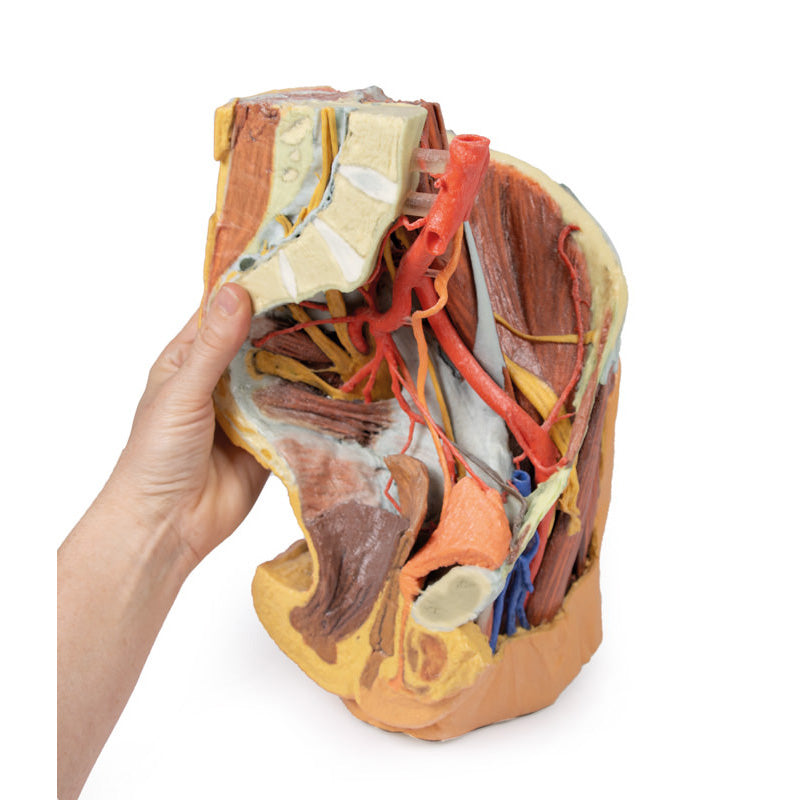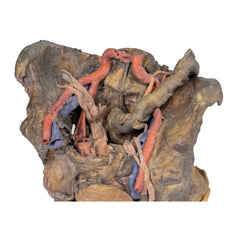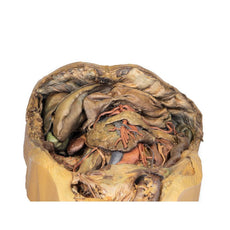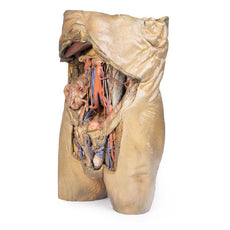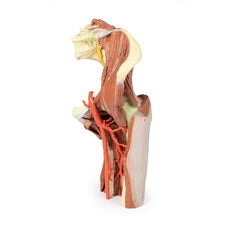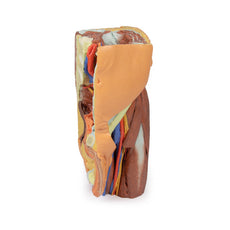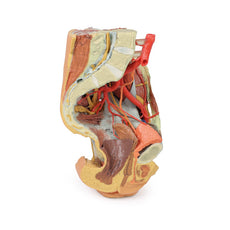Your shopping cart is empty.
3D Printed Female left pelvis and proximal thigh
The abdominal aorta is preserved from the fourth lumbar vertebra to the bifurcation into the common iliac arteries; the root of the inferior mesenteric artery, lumbar arteries, and median sacral artery are also preserved. At the level of the sacral promontory, the common iliac artery bifurcates into the external and internal iliac arteries. Superficial to the sacral ventral rami the major branches of the internal iliac artery are visible (iliolumbar, lateral sacral, superior gluteal, inferior gluteal, internal pudendal, obturator, superior vesicle, obturator, uterine). These latter arterial branches pass to the sectioned bladder (collapsed against the pubis and receiving the ureters), uterus and vagina.
The pelvic viscera (bladder, uterus, vagina and rectum) are visible in the midsagittal section extending to the anterior and posterior triangles of the perineum; in the anterior triangle the sagittal section of the clitoral body and part of the corpus spongiosum are visible inferior to the pubic symphysis.
The external iliac artery passes anteriorly along the pelvic brim, giving rise to the inferior epigastric and deep circumflex iliac arteries before passing deep to the inguinal ligament.
The psoas major and minor muscles pass lateral to the external iliac artery, with the femoral nerve and lateral cutaneous nerve of the thigh resting on the superficial surface of the iliacus muscle. The fascia lata inferior to the inguinal ligament has been removed to expose the muscular borders and contents of the femoral triangle (and surrounding anterior and medial thigh musculature). The great saphenous vein is visible joining the femoral vein adjacent to the femoral artery, with the branches of the femoral nerve just overlying the deep artery of the thigh. The distal cross-section through the proximal femur displays the anterior, medial and posterior compartment musculature, neurovascular bundles (femoral artery and vein, deep artery of the thigh, and the sciatic nerve), and tributaries of the great saphenous vein.
Posteriorly the gluteal region has been dissected to demonstrate deep structures. The gluteus maximus and gluteus medius muscles have been removed exposing the piriformis muscle. Superior to piriformis the superior gluteal artery and nerve pass laterally towards the gluteus minimus. Inferior to piriformis the inferior gluteal artery and nerve are visible (and pinned towards the sectioned edge of the gluteus maximus. The sciatic nerve and posterior cutaneous nerve of the thigh are also visible exiting the greater sciatic foramen inferior to the piriformis, running superficial to the lateral rotators (superior and inferior gemelli, obturator internus, quadratus femoris) and common origin of posterior thigh muscles (semitendinosus, semimembranosus, long head of biceps femoris) from the ischial tuberosity. The sacrotuberous ligament has been sectioned to show the internal pudendal artery and pudendal nerve exiting the greater sciatic foramen to wrap around the sacrospinous ligament and coccygeus muscle to enter the lesser sciatic foramen. The fat of the ischioanal fossa has been removed to demonstrate the course of these vessels in the perineum just lateral to the levator ani and external anal sphincter muscles.
Download Handling Guidelines for 3D Printed Models
GTSimulators by Global Technologies
Erler Zimmer Authorized Dealer

10.0 lb
3D Printed Female left pelvis and proximal thigh
Item # MP1780
$3,461.00
$3,846.00
You save $385.00
Need an estimate?
Click Add To Quote

Features & Specifications
-
by
A trusted GT partner -
FREE Shipping
U.S. Contiguous States Only -
3D Printed Model
from a real specimen -
Gov't pricing
Available upon request
Frequently Bought Together
3D Printed Female left pelvis and proximal thigh
This 3D printed female left pelvis preserves both superficial and deep structures of the true and false pelves, inguinal region, femoral triangle, and gluteal region. The specimen has been sectioned transversely through the fourth lumbar vertebra, displaying the cross-section of the musculature (epaxial musculature, psoas and quadratus lumborum muscles) and cauda equina within the vertebral canal. Ventral and dorsal roots of the cauda equina are also visible exiting the inter-vertebral and sacral foramina in the sagittal section.The abdominal aorta is preserved from the fourth lumbar vertebra to the bifurcation into the common iliac arteries; the root of the inferior mesenteric artery, lumbar arteries, and median sacral artery are also preserved. At the level of the sacral promontory, the common iliac artery bifurcates into the external and internal iliac arteries. Superficial to the sacral ventral rami the major branches of the internal iliac artery are visible (iliolumbar, lateral sacral, superior gluteal, inferior gluteal, internal pudendal, obturator, superior vesicle, obturator, uterine). These latter arterial branches pass to the sectioned bladder (collapsed against the pubis and receiving the ureters), uterus and vagina.
The pelvic viscera (bladder, uterus, vagina and rectum) are visible in the midsagittal section extending to the anterior and posterior triangles of the perineum; in the anterior triangle the sagittal section of the clitoral body and part of the corpus spongiosum are visible inferior to the pubic symphysis.
The external iliac artery passes anteriorly along the pelvic brim, giving rise to the inferior epigastric and deep circumflex iliac arteries before passing deep to the inguinal ligament.
The psoas major and minor muscles pass lateral to the external iliac artery, with the femoral nerve and lateral cutaneous nerve of the thigh resting on the superficial surface of the iliacus muscle. The fascia lata inferior to the inguinal ligament has been removed to expose the muscular borders and contents of the femoral triangle (and surrounding anterior and medial thigh musculature). The great saphenous vein is visible joining the femoral vein adjacent to the femoral artery, with the branches of the femoral nerve just overlying the deep artery of the thigh. The distal cross-section through the proximal femur displays the anterior, medial and posterior compartment musculature, neurovascular bundles (femoral artery and vein, deep artery of the thigh, and the sciatic nerve), and tributaries of the great saphenous vein.
Posteriorly the gluteal region has been dissected to demonstrate deep structures. The gluteus maximus and gluteus medius muscles have been removed exposing the piriformis muscle. Superior to piriformis the superior gluteal artery and nerve pass laterally towards the gluteus minimus. Inferior to piriformis the inferior gluteal artery and nerve are visible (and pinned towards the sectioned edge of the gluteus maximus. The sciatic nerve and posterior cutaneous nerve of the thigh are also visible exiting the greater sciatic foramen inferior to the piriformis, running superficial to the lateral rotators (superior and inferior gemelli, obturator internus, quadratus femoris) and common origin of posterior thigh muscles (semitendinosus, semimembranosus, long head of biceps femoris) from the ischial tuberosity. The sacrotuberous ligament has been sectioned to show the internal pudendal artery and pudendal nerve exiting the greater sciatic foramen to wrap around the sacrospinous ligament and coccygeus muscle to enter the lesser sciatic foramen. The fat of the ischioanal fossa has been removed to demonstrate the course of these vessels in the perineum just lateral to the levator ani and external anal sphincter muscles.
Download Handling Guidelines for 3D Printed Models
GTSimulators by Global Technologies
Erler Zimmer Authorized Dealer
These items normal warranty are two years, however the warranty doesn’t cover “wear and tear”. The manufacturer does have 100% quality control on these models.
The models are very detailed and delicate. With normal production machines you cannot realize such details like shown in these models.
The printer used is a color-plastic printer. This is the most suitable printer for these models.
The plastic material is already the best and most suitable material for these prints. (The other option would be a kind of gypsum, but this is way more fragile. You even cannot get them out of the printer without breaking them).The huge advantage of the prints is that they are very realistic as the data is coming from real human specimen. Nothing is shaped or stylized.
The users have to handle these prints with utmost care. They are not made for touching or bending any thin nerves, arteries, vessels etc. The 3D printed models should sit on a table and just rotated at the table.
The models are very detailed and delicate. With normal production machines you cannot realize such details like shown in these models.
The printer used is a color-plastic printer. This is the most suitable printer for these models.
The plastic material is already the best and most suitable material for these prints. (The other option would be a kind of gypsum, but this is way more fragile. You even cannot get them out of the printer without breaking them).The huge advantage of the prints is that they are very realistic as the data is coming from real human specimen. Nothing is shaped or stylized.
The users have to handle these prints with utmost care. They are not made for touching or bending any thin nerves, arteries, vessels etc. The 3D printed models should sit on a table and just rotated at the table.

by — Item # MP1780
3D Printed Female left pelvis and proximal thigh
$3,461.00
$3,846.00
Add to Cart
Add to Quote









